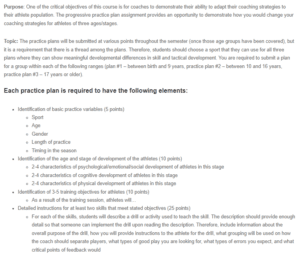Football Progressive Practice Plans
Good coordination is one requirement for any footballer, as the game requires the player to act spontaneously and show resistance by applying motor abilities in constantly changing situations. The Dynamic System Theory of Development requires children between 0-9 years to develop and improve coordination in their development period, leading to the growth of muscles, strength, balance, and coordination (Haibach-Beach et al., 2023). In this regard, this plan will review a progressive practice plan for children between 0-9 years participating in football.
Practice Variables
This is a progressive football practice plan for young boys between 0 to 9 years old. The program will take four weeks, starting with the preseason acclimatization period, and players teams will be subjected to up to 30 minutes of full contact drills on any given day. Coaches will lead the teams into contacting several practices every week.
Age and Stage of Development of the Athletes
Some of the age and stage-appropriate development that the coaches will look for before recruiting the young players to the practice plan include psychological, cognitive, and physical development characteristics. All players must showcase psychological features, including personality traits such as confidence, volition drive, focus, and mental toughness (Slimani et al., 2016). Additionally, players must also have specific cognitive skills necessary for training. These skills include reaction to time, pattern recognition, game intelligence, decision-making, and memory. On the contrary, some physical development characteristics that will be considered include strength, endurance, speed, and flexibility.
Training Objectives
Subjecting players to a range of progressive practice drills will help them develop their football skills. Gradually increasing the training load will allow coaches to improve athletes’ performance through improving their aerobic and anaerobic fitness. Additionally, this training aims to help young players gain strength and flexibility in their young muscles to perform technical actions effectively.
Skills that Meet Stated Objectives
Any football player should possess several skills to maintain flexibility during the game. However, because this is the foundation phase of training, some of the skills I anticipate the players to showcase include ball mastery, dribbling, passing, aerial control, and change of direction. Some activities that will help these players develop these skills include ball manipulation exercises such as toe taps, sole rolls, L-Turn, and drag back. These activities will help the players create their technical and mental resistance towards tackling their opponents. Additionally, the activities will help the players build on their ball control and confidence while playing. However, some errors I expect from the players include failure to adhere to rules, lateness, and seeking short-term results over long-term development. Feedback from the anticipated mistakes will help develop better coaching strategies that benefit all players.
References
Haibach-Beach, P. S., Perreault, M., Brian, A., & Collier, D. H. (2023). Motor learning and development. Human kinetics.
Slimani, M., Bragazzi, N. L., Tod, D., Dellal, A., Hue, O., Cheour, F., & Chamari, K. (2016). Do cognitive training strategies improve motor and positive psychological skills development in soccer players? Insights from a systematic review. Journal of Sports Sciences, 34(24), 2338-2349.
ORDER A PLAGIARISM-FREE PAPER HERE
We’ll write everything from scratch
Question

Football Progressive Practice Plans
Purpose: One of the critical objectives of this course is for coaches to demonstrate their ability to adapt their coaching strategies to their athlete population. The progressive practice plan assignment provides an opportunity to demonstrate how you would change your coaching strategies for athletes of three ages/stages.
Topic: The practice plans will be submitted at various points throughout the semester (once those age groups have been covered), but it is a requirement that there is a thread among the plans. Therefore, students should choose a sport that they can use for all three plans where they can show meaningful developmental differences in skill and tactical development. You are required to submit a plan for a group within each of the following ranges (plan #1 – between birth and 9 years, practice plan #2 – between 10 and 16 years, practice plan #3 – 17 years or older).
Each practice plan is required to have the following elements:
- Identification of basic practice variables (5 points)
- Sport
- Age
- Gender
- Length of practice
- Timing in the season
- Identification of the age and stage of development of the athletes (10 points)
- 2-4 characteristics of psychological/emotional/social development of athletes in this stage
- 2-4 characteristics of cognitive development of athletes in this stage
- 2-4 characteristics of physical development of athletes in this stage
- Identification of 3-5 training objectives for athletes (10 points)
- As a result of the training session, athletes will…
- Detailed instructions for at least two skills that meet stated objectives (25 points)
- For each of the skills, students will describe a drill or activity used to teach the skill. The description should provide enough detail so that someone can implement the drill upon reading the description. Therefore, include information about the overall purpose of the drill, how you will provide instructions to the athlete for the drill, what grouping will be used on how the coach should separate players, what types of good play you are looking for, what types of errors you expect, and what critical points of feedback would


